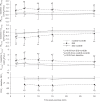Self-reported exercise-induced dyspnea and airways obstruction assessed by oscillometry and spirometry in adolescents
- PMID: 34797002
- PMCID: PMC9299675
- DOI: 10.1111/pai.13702
Self-reported exercise-induced dyspnea and airways obstruction assessed by oscillometry and spirometry in adolescents
Abstract
Background: Self-reported exercise-induced dyspnea (EID) is common among adolescents. Possible underlying pathologies are exercise-induced bronchoconstriction (EIB) and laryngeal obstruction (EILO). The forced oscillation technique (FOT) may evaluate exercise-induced changes in airway caliber.
Aim: To investigate in adolescents the relationship between EID, EIB (post-exercise fall in forced expiratory volume in 1s (FEV1 )≥10%), EILO, and post-exercise challenge changes in FOT parameters.
Methods: One hundred and forty-three subjects (97 with EID) of 13-15 years old underwent a standardized exercise challenge with FOT measurement and spirometry repeatedly performed between 2 and 30 min post-exercise. EILO was studied in a subset of 123 adolescents. Subjects showing greater changes than the healthy subgroup in the modulus of the inspiratory impedance were considered FOT responders.
Results: EID-nonEIB subjects presented similar post-exercise changes in all FOT parameters to nonEID-nonEIB adolescents. Changes in all FOT parameters correlated with FEV1 fall. 45 of 97 EID subjects responded neither by FEV1 nor FOT to exercise. 19 and 18 subjects responded only by FEV1 (onlyFEV1 responders) or FOT (onlyFOTresponders), respectively. Only a lower baseline forced vital capacity (FVC)%predicted and a higher FEV1 /FVC distinguished the onlyFEV1 responders from onlyFOTresponders. FOT parameters did not present specific post-exercise patterns in EILO subjects.
Conclusion: FOT can be used to identify post-exercise changes in lower airway function. However, EID has a modest relation with both FEV1 and FOT responses, highlighting the need for objective testing. More research is needed to understand whether onlyFEV1 responders and onlyFOTresponders represent different endotypes.
Keywords: exercise-induced bronchoconstriction; exercise-induced dyspnea; exercise-induced laryngeal obstruction; forced oscillation technique.
© 2021 The Authors. Pediatric Allergy and Immunology published by European Academy of Allergy and Clinical Immunology and John Wiley & Sons Ltd.
Conflict of interest statement
P.P. and R.D. are co‐founders and serve as board members of RESTECH s.r.l., a company that designs, manufactures, and sells devices for lung function testing based on forced oscillation technique (FOT). R. D. also reports grants and others from Restech, personal fees from Philips Healthcare outside the submitted work. In addition, Dellaca' has a patent on the detection of EFL by FOT with royalties paid to Philips Respironics and Restech s.r.l, a patent on monitoring lung volume recruitment by FOT with royalties paid to Vyaire, and a patent on early detection of exacerbations by home monitoring of FOT with royalties paid to Restech s.r.l. The other authors have nothing to disclose.
Figures



Similar articles
-
Within-breath oscillometry for identifying exercise-induced bronchoconstriction in pediatric patients reporting symptoms with exercise.Front Pediatr. 2024 Jan 11;11:1324413. doi: 10.3389/fped.2023.1324413. eCollection 2023. Front Pediatr. 2024. PMID: 38274467 Free PMC article.
-
Exercise-Induced Bronchoconstriction Identified Using the Forced Oscillation Technique.Front Physiol. 2019 Nov 15;10:1411. doi: 10.3389/fphys.2019.01411. eCollection 2019. Front Physiol. 2019. PMID: 31803065 Free PMC article.
-
Use of the forced-oscillation technique to estimate spirometry values.Int J Chron Obstruct Pulmon Dis. 2017 Oct 3;12:2859-2868. doi: 10.2147/COPD.S143721. eCollection 2017. Int J Chron Obstruct Pulmon Dis. 2017. PMID: 29042766 Free PMC article.
-
The role of cardiopulmonary exercise testing in evaluating children with exercise induced dyspnoea.Paediatr Respir Rev. 2021 Jun;38:24-32. doi: 10.1016/j.prrv.2020.08.002. Epub 2020 Aug 26. Paediatr Respir Rev. 2021. PMID: 32980274 Review.
-
Input oscillometry and the forced oscillation technique for assessing lung function in preschool children with asthma.Pediatr Investig. 2018 May 11;2(1):37-43. doi: 10.1002/ped4.12022. eCollection 2018 Mar. Pediatr Investig. 2018. PMID: 32851228 Free PMC article. Review.
Cited by
-
Diagnostic utility of spirometry for children with induced laryngeal obstruction or chronic non-specific cough.Am J Otolaryngol. 2024 Jul-Aug;45(4):104316. doi: 10.1016/j.amjoto.2024.104316. Epub 2024 Apr 23. Am J Otolaryngol. 2024. PMID: 38677150 Free PMC article.
-
Peripheral airways dysfunction measured by oscillometry differentiates asthma from inducible laryngeal obstruction.Respir Med. 2025 Jan;236:107905. doi: 10.1016/j.rmed.2024.107905. Epub 2024 Dec 3. Respir Med. 2025. PMID: 39631550
-
Within-breath oscillometry for identifying exercise-induced bronchoconstriction in pediatric patients reporting symptoms with exercise.Front Pediatr. 2024 Jan 11;11:1324413. doi: 10.3389/fped.2023.1324413. eCollection 2023. Front Pediatr. 2024. PMID: 38274467 Free PMC article.
References
-
- Johansson H, Norlander K, Hedenström H, et al. Exercise‐induced dyspnea is a problem among the general adolescent population. Respir Med. 2014;108:852‐858. - PubMed
-
- Johansson H, Norlander K, Berglund L, et al. Prevalence of exercise‐induced bronchoconstriction and exercise‐induced laryngeal obstruction in a general adolescent population. Thorax. 2015;70:57‐63. - PubMed
-
- Johansson H, Norlander K, Malinovschi A. Increased prevalence of exercise‐induced airway symptoms – A five‐year follow‐up from adolescence to young adulthood. Respir Med. 2019;154:76‐81. - PubMed
-
- Weiler JM, Brannan JD, Randolph CC, et al. Exercise‐induced bronchoconstriction update—2016. J Allergy Clin Immunol. 2016;138(5):1292‐1295.e36. - PubMed
Publication types
MeSH terms
LinkOut - more resources
Full Text Sources
Medical

